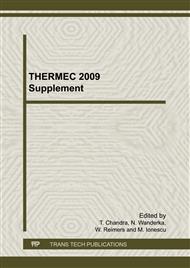p.256
p.262
p.268
p.275
p.281
p.285
p.290
p.295
p.301
Density Gradient Materials by Direct Metal Laser Sintering
Abstract:
The direct metal laser sintering process was applied to produce density gradient materials of stainless steel 316L. In order to understand the mechanism of forming porous structure, the influence of laser power, scan rate and scan pitch on the porosity were investigated by measuring density of produced samples and observing cross-sectional microstructures. Laser power greatly affected to the porosity by forming clusters of melted metal powders. It was found that the size change of clusters plays a role in forming porous structure. Eventually, three dimensional sample owing density gradient structures was manufactured.
Info:
Periodical:
Pages:
281-284
Citation:
Online since:
January 2010
Authors:
Price:
Сopyright:
© 2010 Trans Tech Publications Ltd. All Rights Reserved
Share:
Citation:


